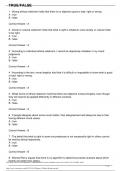EQUITY
TABLE OF CONTENTS
BASIC CONCEPTS/DEBATES: P.2
REQUIREMENTS OF AN EXPRESS TRUST: P.7
CONSTITUTION OF TRUSTS P.13
DISPOSITIVE POWERS/DUTIES & ADMIN OF TRUSTS: P.18
PERSONAL LIABILITY FOR BREACH & FIDUCIARIES: P.30
PROPRIETARY REMEDIES & TRACING : P.40
PERSONAL LIABILITY OF THIRD PARTIES 7: P.51
RESULTING TRUSTS: P.60
CHARITABLE PURPOSE TRUSTS: P.69
Page 1 of 76
,EQUITY NOTES SUPERVISION 1: BASIC CONCEPTS/DEBATES
EQUITY ii) UNCONSCIONABILITY
• Body of law developed from courts of Chancery - as opposed to CL - from CL • Most important - restrains injustice by stopping uncons. conduct (Evershed)
courts • ‘Eq operates on the conscience of the owner of the legal interest’ - Lord BW,
• Where reliance on strict legal rights may lead to unfairness Eq may intervene to WLG v Islington LBC
ensure just result • unclear how to determine though - used by conscience of LC - now less clear
• from Mid. Ages, CL = formalistic body of rules - strictly interpreted • can query whose conscience? Parties? Judges?
• possible petition King (later Chancellor) for discretionary remedy where CL = • Important work out whether = rule or guiding principle
harsh/no remedy - led to creation of Chancery • If rule, need clear definition, if guiding then courts will manipulate to get just
• Lord Chancellor Cowper: Equity moderates & reforms the rigour, hardness & result
edge of the law • Aus use unconscionability as guiding principle giving discretion - Eng =
• characterised by flexibility - originally based on ideas of fairness/justice/ substantive doctrine
morality • Lord Templeman, Winkworth & Edward Baron Eq is not a computer…
• Seldon: Equity varies with the length of the Chancellors foot operates on conscience
• considered it rogue & uncertain - hard predict outcomes - Eq acts ‘in personam’
MODERN CONTRIBUTION
• over time became more principled & rule-based & doctrinal - judges took over
jurisdiction • Lord Denning MR, Eves v Eves 75: “Equity is not past the age of child
• Struggle between CL & Eq over which should prevail - Eq won - Earl of bearing”
Oxford’s Case 1615 • still provides new solutions to modern problems
• Dual structure meant legal system not ideal - inconvenience & injustice • big contribution to remedies e.g specific performance/injunctions
• If chose wrong court, hard start again! • ofc trusts, too
• Dickens (Bleak-House): wrote of ‘slipper precedents… knee deep in
technicalities’ ASSIMILATION OF COMMON LAW & EQUITY
• complexity part resolved by Judicature Acts 1873 & 75 - abolished CL & • Although Eq prevails over CL, Eq is ‘secondary’ & supposes prior existence of
Chancery courts CL
• replaced with single High Court - fused (procedurally) the administration of CL • Maitland: Eq rules insufficient in themselves - CL could stand alone but Eq
& Eq - but not the bodies of law! couldn’t
• s49 SCA 81 recognised HC can apply Eq remedies • Kitto J: ‘Eq is the appendix the Chancery was composing for saving the Cl & is
• but s49(1) also recognised Eq > CL - but closely related! not an independent system of law
• Though procedurally fused (good e.g = Berry v Berry 29) Virgo agues clearly
CHARACTERISTICS not substantively
i) DISCRETIONARY • Eq proprietary interests & legal interests are distant - trusts depend on this
• less so today - need precedent - not enough think of ‘justice’ in the case - Re • Characteristics of rights depend on Eq/legal e.g if legal owner & property
Diplock stolen, get damages but if equitable owner, recover property & with money eq
• Sir George Jessel MR said rules progressive - look to modern rather than old can identify it from a mix
precedents -Re Hallett’s Estate • Birks questions whether Eq is anomaly to priv law scholarship - ‘event-based-
• Still some discretion - in remedies - consider justice/fairness scheme of priv law has no place for Equity
Page 2 of 76
,EQUITY NOTES
• Virgo disagrees - must be a place for Eq within priv law • here underlying concept of ‘civil wrong’ & damages avail (compensatory,
• but is there a good justification? A historical scheme based on conscience restitutionary, punitive) for anticipated & accrued wrongs
• but My opinion: not an accident - developed to enhance justice & so engrained • says need for coherence & treating like cases alike
(esp. property) that can’t ignore • says 3 categories: (i) CL/Eq exist coherently e.g trusts
(ii)Exist coherently but nothing gained by labels e.g duress/
EVIDENCE OF ASSIMILATION UI
• Burrows: as law develops judges borrow ideas across the divide -> inspires (iii)CL/Eq doesn’t exist coherently - need change!
development • (iii) illustrated by monetary remedies - law treats same facts differently but both
recognise ‘wrong’
1) Sempra Metals v IRC 07 confirmed compound interests avail for claims
• e.g compensation - damages (CL) & equitable comp (EQ) - not that diff so
regardless of whether arose in CL/Eq - though traditionally CL doctrine
should assimilate
2) AG v Blake CL rights but gain-based remedy (typically Eq remedy) - hard
• e.g restitution for wrongs - both appear allow
case = bad law, though similarly Aquoculture v NZ Green Mussel Co 90
• e.g punishment - CL could take Eq approach (as in NZ/Canada)
sued for breach of confidence (Eq doctrine) but got exemplary damages (CL
• says issue of defences over-state
heritage)
• thus Burrows argues for partial fusion!
3) Rescission at CL effected by election of party wanting rescind but in Eq by
court order where court has discretion determine if apt - thus rule has
• Worthington also argues for fusion - gives e.g of 2 games of football
become no rescission if parties cant be destored - mix of two…
developing - incoherent - continued dualism is unjustifiable - like cases not alike
• but as acknowledged in Halpern v Halpern where concurrent jurisdiction, Eq
& different remedial techniques cause incoherence
applies to extent that they conflict - (same as s49(1))
• Worthington argues practically wouldn’t be that difficult - already do it e.g
• also all other cases can surely be explained as Eq intervening to prove remedy?
injunctions
• rather than fusion examples of Eq doing its traditional role
• suggests could define trust as ‘right to enjoy defined benefits and have them
SHOULD THEY BE ASSIMILATED/FUSED? afforded special protection against interference by 3Ps & special advantages with
transferability’
• Martin argues keep separate! Says fallacy that JAs somehow codified law into • but Virgo says this would make trust more complicated & subtleties/nuances
one lost
• if we ignore origins/nature of rights/remedies then reach absurd position e.g • Worthington also argues jurisprudentially, not that hard coz gap not that big
should Eq defence of ‘hardship’ be avail to defend breach of contract? • cross-fertilisation going on for years, rationales not that different - CL somewhat
• denying fusion doesn’t mean Eq/CL can’t continue develop- should encourage more positivist but this is over simplistic - notes Burrows’ points about ‘wrongs’
them develop beneficially to influence of other where apt similarities
• Virgo presumably agrees - his comments above on trusts etc • also argument that Eq to discretionary out-dated & untrue today
• but Denning in United Specific Holdings during the time since JAs the • My opinion: agrees with Burrows assimilation in remedies etc valid & would
streams of Eq & law have flown together & combined to be indistinguishable aid coherent but should leave trusts alone - generally involves brining CL in line
from one another with Eq
• Burrows argues must be take fusion seriously - says would only take small step • but Lord Millett (extra j) said 3 greatest jurisprudential systems of Western
to assimilate world have all been dual: Jewish, Roman & English
• only need assimilate monetary remedies for CL & Eq wrongs • in each, one part gave certainty, the other gave justice (flexibility)
Page 3 of 76
,EQUITY NOTES
• but certainly with Roman Law, it evolved to create civil system - where no ii. Those who come to Eq must come with clean hand
separation! • but conduct must be linked to relief sought - Argyll v Argyll - adultery irrel
to confidential info
• Dangers of over-simplified reductionism also worth consideration - is it worth • Tinsley v Milligan: maxim won’t stop relief where C doesn’t have to rely on
for sake of appearance? e.g is loss caused by misapplication of trust fund same improper conduct for claim
as loss caused by breach of duty of care? iii. Eq treats as done what ought be done
• Can ask whether Eq’s separation actually undermines rational integrity of law, as • e.g specific performance e.g Walsh v Lonsdale constructive trust created
Birks suggests (here agreed sell land but didn’t)
iv. Equity protects weak & vulnerable: e.g UI doctrine
EQUITABLE RIGHTS v. Equity is cynical
• Division between personal & proprietary rights • e.g when gift equity presumes didn’t intend gift - recipient holds on trust
• but 3 advantages to proprietary: • assumes certain r/s exploitative i.e doc/patient Mitchell v Homfray
i) Priority over other creditors of D • also e.g he who profits from fiduciary r/s must disgorge - Boardman v
ii) Where not security & increase in value, C will get the benefit! Phipps
iii) C can assert prop right against C (except where bf w.o notice) vi. Equity is imaginative
• more flex than CL - e.g where money mixed still recoverable -El Ajou v
i) PROPRIETARY Dollar Land Holdings
• must be specifically created - expressly, impliedly or by operation of law vii. Equity follows the law
• but note destroyed if 1 person holds legal & eq title - WLG v Islington • ambiguous - recognises legal rules but still develops its own - is secondary -
• can plan successive rights (only poss at CL for land) e.g estate to wife for life Cardozo J: equity follows law but not slavishly/always
with remainder to child) • e.g Jones v Kernott starting point that JTS in law & Eq
• note Current E interest = interest in possession viii. Equity looks to substance rather than the form e.g Walsh v Londsdale
• future interest: vested interest ix. Equity will not assist a volunteer
• where not until/unless some future event: contingent interest • e.g Eq won’t prefect an imperfect gift - but exceptions!
• entitlement may depend on satisfaction of condition: condition precedent x. Equity = equality
• Remember: joint tenancy = owners own whole together - undivided shares - • Eq presumes eq interests in property are equal - except where no intention:
survivorship tenancy in common = definite shares separately McPhail
xi. Where equities equal, 1st in time prevails MacMillan v BishopGate Trust
ii) PERSONAL xii. Eq assists the diligent e.g doctrine of laches
• most significant = fiduciary duties xiii. Eq acts in personam prop rights but not in rem, just in personam (coz bf
• also personal rights from wrongdoing e.g breach of trust rule)
• dividing line can be hard e.g rescission
• can ofc have both TRUSTS
EQUITABLE MAXIMS
• Nature/function has changed throughout history - originally = conveyancing
• mantra of Eq - useful generalisations but rarely decisive device to avoid liabilities/restrictions on inheritance etc - the ‘use’ - while away
i. Those who seek Eq must do Eq - C must be willing act fairly e.g fighting crusades etc
• e.g Chappel v Times Newspapers: injunction denied to employees who • nowadays Langbein argues more important in econ terms - in terms of
refused rule out striking again commerce etc
• Various definitions given:
Page 4 of 76
, EQUITY NOTES
• Maitland: ‘when person has rights bound to exercise on behalf of another/for • Scheme advocated by Birks e.g consent/wrongs/UE
some particular purpose he is said to have those rights in trust for that other…’ • but not endorsed by courts!
• similar in Recognition of Trusts Act 87 • potentially v broad & there are other events which trigger e.g unconscionable
conduct not amounting to recognised wrongs
• Thus 2 fundamental features:
• also no trusts triggered by UE in case law
• Property component - T holds prop rights for person/purpose
• Virgo says unhelpful at best - at worst, distorts understanding
• Obligation component- T obliged exercise those rights for that person/purpose
• Prop component = essence of trust (split between legal/Eq - key if insolvent) ii) BY CONTEXT
• but: both vital - obligation bit emphasis duties - mainly that can’t benefit • Preferable - McBride, Davies & Virgo - can identify various (not mutually
• Langbein gives a ‘contractarian account’ of the trust exclusive)
• considers the deal between S & T as indistinguishable from 3P beneficiary i. Express trusts: intentionally created by Settlor/testator
contract • Fixed trusts - interests specified in trust doc
• views as straddling contract & property - ‘trusts are contracts’ • Discretionary trust - Ts have discretion ‘appoint’ property to objects
• historically contract insufficiently developed & only about land thus property • Inter vivos - settlor alive
analysis easier • Testamentary - will
• trust deal is voluntary & most true law = default law (rules parties can reject in • Bare trusts - property vested in T for sole benefit of B
trust docs) • Private - for individuals/groups
• says consensual formation & party autonomy = fundamentals of contract • Public - charitable/for benefit of public
• but insolvency: why is trust property prioritised? Langbein accepts prop • Protective - protects B’s assets from threat of bankruptcy
element • Pension funds
• thus argues not assimilate trusts & contracts but empathising contractarian basis
broadly ii. Resulting trusts: intentions of transferor presume = that property to be held
• Scott pointed out contract can’t explain ‘tracing’ but Langbein says is j on trust for him
enforcing trust deal • property ‘results' back in settlor
• Also criticisms - Virgo: • T will hold prop on resulting trust where S fails create express trust
• Once created S can’t enforce the ‘bargain’ except where powers reserved - not v
contractarian iii. Constructive trusts - arise through application of legal rules
• Testamentary trusts not really bargains either
• S can declare himself T - no contract! FUNCTION OF TRUSTS
i. Segregation of assets: as long as S not the beneficiary then assets protected
FUNDAMENTAL PRINCIPLES from consequences & also protected if T insolvent
• per LBW in WLG v Islington LBC ii. Asset partitioning: ability take asset & create diff rights in it e.g successive
i) Conscience - trust operates on conscience of legal owner enjoyment
ii) Awareness of facts affecting conscience - conscience can’t be affected iii. Management of property: T managing property on B’s behalf - useful in
otherwise commercial or family context
iii) Identifiable property iv. Tax avoidance: if T can benefit from better role of tax etc - different from
iv) B has equitable prop interst ‘tax evasion’
• IRC v Duke of Westminster arranging affairs to minimise tax fine - main
CLASSIFICATION OF TRUSTS
purpose of evading tax then = abusive
i) BY EVENT
Page 5 of 76







